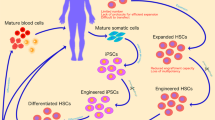Abstract
Although gene transfer into hematopoietic stem cells holds a considerable therapeutic potential, clinical trials targeting this cell compartment have achieved limited success. Poor transduction efficiency with gene transfer vectors used in human studies has hindered delivering therapeutic genes to clinically relevant numbers of target cells. One way to overcome the lowefficiency problem is by selecting or expanding the number of genetically modified cells to a suprathreshold level to achieve clinical efficacy. This approach may be further classified into 2 categories: one is to transfer a drug resistance gene and eliminate unmodified cells with cytotoxic drugs, and the other is to confer a direct growth advantage on target cells.This review aims at an overview of recent advances involving these strategies, with some details of “selective amplifier genes,” a novel system that we have developed for specific expansion of genetically modified hematopoietic cells.Int J Hematol. 2002;76:299-304.
Similar content being viewed by others
References
Richter J, Karlsson S. Clinical gene therapy in hematology: past and future.Int J Hematol. 2001;73:162–169.
Emery DW, Nishino T, Murata K, Fragkos M, Stamatoyannopoulos G. Hematopoietic stem cell gene therapy.Int J Hematol. 2002;75: 228–236.
Miller DG, Adam MA, Miller AD. Gene transfer by retrovirus vectors occurs only in cells that are actively replicating at the time of infection.Mol Cell Biol. 1990;10:4239–4242.
Orlic D, Girard LJ, Jordan CT, et al. The level of mRNA encoding the amphotropic retrovirus receptor in mouse and human hematopoietic stem cells is low and correlates with the efficiency of retrovirus transduction.Proc Natl Acad Sci U S A. 1996;93:11097–11102.
Naldini L, Blömer U, Gallay P, et al. In vivo delivery and stable transduction of nondividing cells by a lentiviral vector.Science. 1996;272:263–267.
Miyoshi H, Smith KA, Mosier DE, et al. Transduction of human CD34+ cells that mediate long-term engraftment of NOD/SCID mice by HIV vectors.Science. 1999;283:682–686.
Moscow JA, Huang H, Carter C, et al. Engraftment ofMDR1 and NeoR gene-transduced hematopoietic cells after breast cancer chemotherapy.Blood. 1999;94:52–61.
Abonour R, Williams DA, Einhorn L, et al. Efficient retrovirusmediated transfer of the multidrug resistance 1 gene into autologous human long-term repopulating hematopoietic stem cells.Nat Med. 2000;6:652–658.
Hanenberg H, Xiao XL, Dilloo D, Hashino K, Kato I, Williams DA. Colocalization of retrovirus and target cells on specific fibronectin fragments increases genetic transduction of mammalian cells.Nat Med. 1996;2:876–882.
Allay JA, Persons DA, Galipeau J, et al.In vivo selection of retrovirally transduced hematopoietic stem cells.Nat Med. 1998;4: 1136–1143.
Davis BM, Koc ON, Gerson SL. Limiting numbers of G156A Op6methylguanine-DNA methyltransferase-transduced marrow progenitors repopulate nonmyeloablated mice after drug selection.Blood. 2000;95:3078–3084.
Sawai N, Zhou S, Vanin EF, Houghton P, Brent TP, Sorrentino BP. Protection andin vivo selection of hematopoietic stem cells using temozolomide, Op6-benzylguanine, and an alkyltransferase-expressing retroviral vector.Mol Ther. 2001;3:78–87.
Cavazzana-Calvo M, Hacein-Bey S, de Saint Basile G, et al. Gene therapy of human severe combined immunodeficiency (SCID)-X1 disease.Science. 2000;288:669–672.
Hacein-Bey-Abina S, Le Deist F, Carlier F, et al. Sustained correction of X-linked severe combined immunodeficiency by ex vivo gene therapy.N Engl J Med. 2002;346:1185–1193.
Cavazzana-Calvo M.«in this issue»
Kume A, Koremoto M, Mizukami H, et al. Selective growth advantage of wild-type lymphocytes in X-linked SCID recipients.Bone Marrow Transplant. 2002;30:113–118.
Mattioni T, Louvion J-F, Picard D. Regulation of protein activities by fusion to steroid binding domains.Methods Cell Biol. 1994;43: 335–352.
Ito K, Ueda Y, Kokubun M, et al. Development of a novel selective amplifier gene for controllable expansion of transduced hematopoietic cells.Blood. 1997;90:3884–3892.
Danielian PS, White R, Hoare SA, Fawell SE, Parker MG. Identification of residues in the estrogen receptor that confer differential sensitivity to estrogen and hydroxytamoxifen.Mol Endocrinol. 1993;7:232–240.
Littlewood TD, Hancock DC, Danielian PS, Parker MG, Evan GI. A modified oestrogen receptor ligand-binding domain as an improved switch for the regulation of heterologous protein.Nucleic Acids Res. 1995;23:1686–1690.
Xu R, Kume A, Matsuda KM, et al. A selective amplifier gene for tamoxifen-inducible expansion of hematopoietic cells.J Gene Med. 1999;1:236–244.
Yoshikawa A, Murakami H, Nagata S. Distinct signal transduction through the tyrosine-containing domains of the granulocyte colony-stimulating factor receptor.EMBO J. 1995;14:5288–5296.
Matsuda KM, Kume A, Ueda Y, et al. Development of a modified selective amplifier gene for hematopoietic stem cell gene therapy.Gene Ther. 1999;6:1038–1044.
Kume A, Koremoto M, Xu R, et al. In vivo expansion of transduced murine hematopoietic cells with a selective amplifier gene.J Gene Med., in press.
Hanazono Y, Nagashima T, Takatoku M, et al.In vivo expansion of transduced murine hematopoietic cells with a selective amplifier gene.Gene Ther. 2002;9:1055–1064.
Neff T, Blau CA. Pharmacologically regulated cell therapy.Blood. 2001;97:2535–2540.
Zeng H, Masuko M, Jin L, Neff T, Otto KG, Blau CA. Receptor specificity in the self-renewal and differentiation of primary multipotential hematopoietic cells.Blood. 2001;98:328–334.
Jin L, Zeng H, Chien S, et al.In vivo selection using a cell-growth switch.Nat Genet. 2000;26:64–66.
Ueda H, Kawahara M, Aburatani T, et al. Cell-growth control by monomeric antigen: the cell surface expression of lysozyme-specific Ig V-domains fused to truncated Epo receptor.J Immunol Methods. 2000;241:159–170.
Lawrence HJ, Sauvageau G, Humphries RK, Largman C. The role ofHOX homeobox genes in normal and leukemic hematopoiesis.Stem Cells. 1996;14:281–291.
Sauvageau G, Thorsteinsdottir U, Eaves CJ, et al. Overexpression ofHOXB4 in hematopoietic cells causes the selective expansion of more primitive populations in vitro and in vivo.Genes Dev. 1995;9: 1753–1765.
Thorsteinsdottir U, Sauvageau G, Hough MR, et al. Overexpression ofHOXA10 in murine hematopoietic cells perturbs both myeloid and lymphoid differentiation and leads to acute myeloid leukemia.Mol Cell Biol. 1997;17:495–505.
Antonchuk J, Sauvageau G, Humphries RK. HOXB4 overexpression mediates very rapid stem cell regeneration and competitive hematopoietic repopulation.Exp Hematol. 2001;29:1125–1134.
Antonchuk J*, Sauvageau G*, Humphries RK. HOXB4-induced expansion of adult hematopoietic stem cells ex vivo.Cell. 2002;109: 39–45.
Kyba M, Perlingeiro RCR, Daley GQ. HoxB4 confers definitive lymphoid-myeloid engraftment potential on embryonic stem cell and yolk sac hematopoietic progenitors.Cell. 2002;109:29–37.
Author information
Authors and Affiliations
Corresponding author
About this article
Cite this article
Kume, A., Hanazono, Y., Mizukami, H. et al. Selective Expansion of Transduced Cells for Hematopoietic Stem Cell Gene Therapy. Int J Hematol 76, 299–304 (2002). https://doi.org/10.1007/BF02982687
Received:
Accepted:
Published:
Issue Date:
DOI: https://doi.org/10.1007/BF02982687




